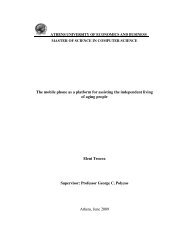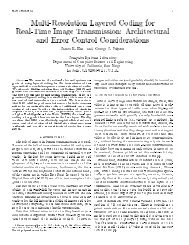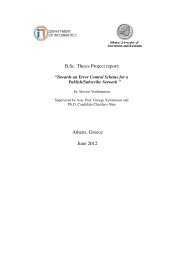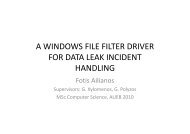In Network Processing and Data Aggregation in
In Network Processing and Data Aggregation in
In Network Processing and Data Aggregation in
Create successful ePaper yourself
Turn your PDF publications into a flip-book with our unique Google optimized e-Paper software.
2.1.3 Proposed schemesSeveral systems suggested physical layer solutions that provide APIs for upper layerslike sett<strong>in</strong>g the radio <strong>in</strong>to different states (sleep, idle, reception, transmission). It isnoticeable the lack of st<strong>and</strong>ardization at lower <strong>and</strong> the (physical) sensor hardware. <strong>In</strong> thefollow<strong>in</strong>g paragraphs we mention the most significant <strong>and</strong> popular schemes that wereproposed.Bluetooth [13]Operates <strong>in</strong> the 2.4 GHz ISM b<strong>and</strong>. It employs b<strong>in</strong>ary Gaussian Frequency ShiftKey<strong>in</strong>g (GFSK), 1 MBaud - symbol rate of. Performs frequency hopp<strong>in</strong>g spreadspectrum, r<strong>and</strong>omly hopp<strong>in</strong>g across 79 channels (1 MHz each one), perform<strong>in</strong>g 1600hops per second. Although it is frequently suggested for sensor applications, theBluetooth physical layer is not very suitable for WSNs [12]. This is ma<strong>in</strong>ly because itconsumes a lot of power search<strong>in</strong>g the b<strong>and</strong> for the network on a packet rate time scale(frequency hopp<strong>in</strong>g). What is more, the narrow channel separation makes the phase noiserequirements of signal sources more difficult.IEEE 802.11b WLAN [15]Operates <strong>in</strong> the 2.4 GHz ISM b<strong>and</strong>. This worldwide IEEE st<strong>and</strong>ard, specifies threedifferent layer-1 options at 1 Mb/s <strong>and</strong> optionally 2 Mb/s:• <strong>In</strong>frared,• Frequency hopp<strong>in</strong>g spread spectrum 2.4 GHz <strong>and</strong>• Direct Sequence spread spectrum 2.4 GHz [DBPSK at 1 Mb/s <strong>and</strong> DQPSK at 2Mb/s. Us<strong>in</strong>g complementary code key<strong>in</strong>g CCK it achieves till 11Mb/s].The 1- <strong>and</strong> 2-MHz direct sequence 802.11 physical layer is a possible option for aWSN because it has m<strong>in</strong>imal hardware requirements, the provided data rate is more thanenough <strong>and</strong> it has not the problems of the frequency hopp<strong>in</strong>g systems (like bluetooth).Us<strong>in</strong>g the extended version (CCK) of the direct sequence option has a big cost <strong>in</strong> powerconsumption <strong>and</strong> transceiver hardware complexity (e.g. have to support complexidentification <strong>and</strong> decod<strong>in</strong>g functions for the CCK sequences).μAMPS [12]








